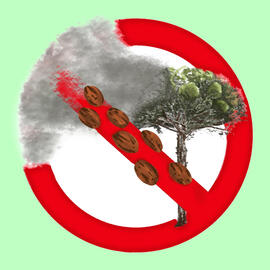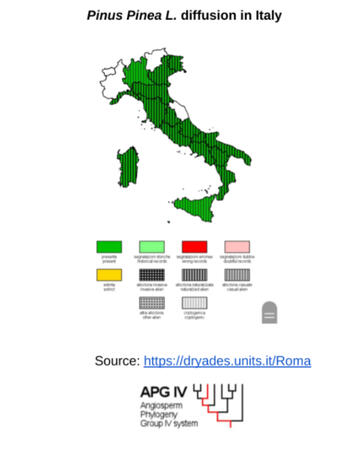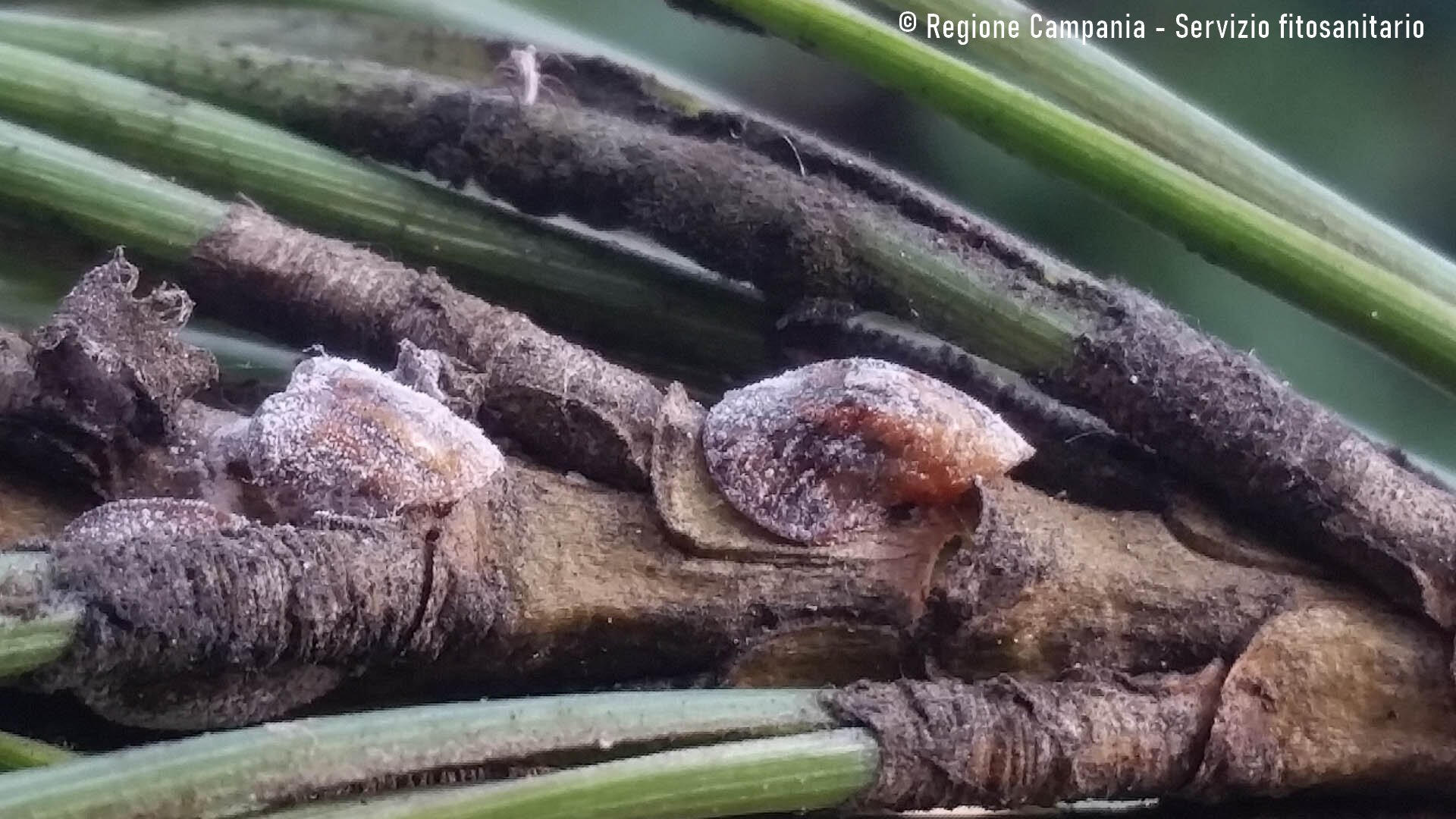“Come i pini di Roma…”
(Cronaca di una morte... silenziosa)
Scuola: Liceo Scientifico Ettore Majorana, Roma (Italia)
Team: IIAs_Coccinigliabusters
Docente referente: Mazzeo Claudia
Titolo del progetto
“Come i pini di Roma…” (Cronaca di una morte ... silenziosa)
ㅤ
Qual è il problema di ricerca?
Come il cambiamento climatico influenza la diffusione di Toumeyella parvicornis su Pinus pinea L., 1753? Il caso della Tenuta di Castelporziano (RM).
ㅤ
Problema di ricerca: Descrizione
Autunno 2014, Napoli: Prima segnalazione della presenza di Toumeyella parvicornis, un insetto nativo del Nord America che rappresenta una pericolosa minaccia per la sopravvivenza dei pini, in particolare di Pinus pinea L.
2018, Roma: la Toumeyella parvicornis colpisce visibilmente i pini, soprattutto quelli situati nella zona Sud della città.
Quali condizioni climatiche facilitano la diffusione del parassita e come si stabilizzano le aree o il numero delle generazioni infestanti? L'area di ricerca della pineta romana di Castelporziano si trova all'interno della Tenuta del Presidente della Repubblica. L'obiettivo è descrivere la situazione attuale ed individuare metodi efficaci per il recupero dell'equilibrio ecologico.Tipo di dati di Osservazione della Terra:
Misurazioni
Immagini satellitari
Altri da visita in loco
Pianificazione delle attività
connesse alla ricerca:
● Ricerca siti web e bibliografia;
studio di articoli scientifici.
●Immagini satellitari per valutare la
distribuzione di Pinus pinea L., prima
e dopo la diffusione del parassita,
sia nell'area di studio che nel
territorio nazionale ed europeo.
●Dati di copertura delle altre specie
di Pinus in Italia, prima e dopo la
diffusione del parassita.
● Ricerca e analisi di dati relativi ai
cambiamenti climatici nell'area di
studio, inclusi quelli relativi alle
condizioni di pioggia e vento.
● Ricerca sul campo: visita alla
Tenuta di Castelporziano, con
possibilità di raccolta di materiale
fotografico e video.
● Consulenza da parte dei tecnici
dell'area protetta, con possibilità di
condivisione dei dati della ricerca
🏠︎ Pinus pinea L., 1753
Caratteristiche generaliAlbero originario della regione mediterranea dell'Europa meridionale e delle coste dell'Asia Minore, Pinus Pinea L., 1753 è presente in quasi tutte le regioni italiane. La sua diffusione storica nella penisola italiana si deve a Fenici, Etruschi e Romani; attualmente è coltivato per i suoi semi commestibili e per rimboschire le pinete costiere. È noto anche come Pino domestico, Pino ombrello o Pino dei pinoli. Il Pino domestico può raggiungere i 20 metri di altezza: ha un tronco dritto e una chioma ingrossata a forma di ombrello. La sua corteccia si sgretola durante la sua vita e forma grandi placche vagamente rettangolari che si sfaldano. Le foglie sono riunite in fasci: gli aghi possono raggiungere i 20 centimetri di lunghezza. Le pigne del Pino domestico sono più grandi di quelle degli altri pini: sono legnose e hanno semi commestibili (pinoli), privi di ali.
Il Pino domestico si propaga solo per semi che maturano dal terzo anno. Ha un temperamento termofilo e sopporta male temperature minime medie invernali inferiori ai 10 gradi centigradi. Il pino domestico è tipico del Mediterraneo settentrionale, dalla Turchia alla Penisola Iberica, ed è presente anche in alcuni tratti costieri del Mar Nero. Se ha scopo ornamentale, lo si può trovare anche fuori dalla regione mediterranea. In Italia è diffuso soprattutto nelle fasce costiere, dalla Sicilia alla Toscana, sul Mar Tirreno, ma lo si può trovare anche nell'area interna di quasi tutte le regioni italiane, non oltre i 1000 metri di altezza.
I pini di RomaIl paesaggio di Roma e dei suoi dintorni è caratterizzato dalla presenza di Pinus pinea L. .
Nonostante la significativa presenza di Pinus pinea L., per Roma non si può parlare di vegetazione autoctona; infatti Pinus pinea L. è stato introdotto in età arcaica ed è quindi presente nel territorio capitolino "solo" dall'epoca degli antichi romani. I primi alberi furono piantati non solo per la loro capacità di abbellire le strade ma anche per il pregiato legno e per la resina, entrambi materiali considerati di grande pregio, oltre che per i pinoli. Questa pratica ha contribuito a diffondere la presenza di pini domestici nel territorio circostante a Roma, dove questi alberi offrono ombra rigenerante e sono un elemento chiave del paesaggio, per il collegamento tra la storia millenaria della città e l'attuale situazione urbana.Qual è il motivo della presenza delle pinete a Roma?
La storia delle pinete romane inizia nel 1710 quando la famiglia Sacchetti, proprietaria anche della tenuta di Castel Fusano, nel tentativo di sfruttare in senso produttivo quei terreni, per lo più paludosi e malsani, decise di piantare il pino domestico per produrre pinoli. L'opera di propagazione e cura della pineta fu continuata dalla famiglia Chigi, cui passò nel 1755 la proprietà della tenuta. Castel Fusano è quindi il primo e più antico nucleo di pineta. Il secondo significativo ampliamento della pineta avvenne tra il 1870 e il 1887, con la piantagione realizzata nei pressi della grande duna costiera posta alle spalle della spiaggia.
La tradizione di piantare strategicamente i pini è continuata nei secoli: nella zona Sud della Capitale, nata attorno al quartiere EUR, con uno straordinario e continuo sviluppo urbanistico, Pinus pinea L. fu deliberatamente scelta, in epoca fascista, nei programmi urbanistici che, guardando al mito dell'Impero romano, recuperarono la vegetazione di Pinus pinea L. come elemento di continuità con il passato; allo stesso modo è possibile giustificare la presenza ordinata e regolare di Pinus pinea L. lungo l'asse viario di Viale Cristoforo Colombo: le piante furono messe a dimora in previsione dell'Esposizione Universale che si sarebbe tenuta a Roma nel 1942. Il filare di pini, alberi geometricamente perfetti e in sintonia con il razionalismo architettonico dell'EUR, che dal centro di Roma conduceva a Ostia - il mare della città -, contribuiva a creare una scenografia solenne.
Pinus pinea L.: gli agenti patogeniCome tutti gli esseri viventi, anche gli alberi subiscono attacchi da parte di patogeni: insetti, funghi, batteri o virus. In condizioni normali, si verifica una situazione di equilibrio in cui gli alberi più stressati o deboli vengono colpiti dai patogeni, mentre gli altri resistono agli attacchi. Esistono però situazioni di eccezionalità e di rottura dell'equilibrio, in cui la comunità vegetale non è in grado di resistere all'attacco o perché la salute delle singole piante e dell'intera comunità è già compromessa dalle condizioni ambientali esterne o perché l'attacco è particolarmente destabilizzante.
Questa situazione è ulteriormente aggravata dalla possibile mancanza di varietà genetica delle piante che rende l'intera comunità più debole.
Come vedremo, la grave aggressione patogena subita da Pinus pinea L. negli ultimi anni è caratterizzata da tutti questi fattori: i pini si trovavano già in una situazione di stress ambientale quando sono stati attaccati da patogeni alieni, sconosciuti e particolarmente aggressivi; e l'assenza di varietà genetica che caratterizza il pino domestico (per cui i pini sono tutti geneticamente "gemelli" tra loro e quindi con identiche e immutabili capacità di resistenza e modificazione) ha ridotto al minimo le capacità di resilienza di Pinus pinea L. di fronte all'aggressione patogena.
Quest'ultimo fattore è particolarmente grave nelle pinete, perché le piante non sono solo monospecifiche ma anche coeve e impiantate dall'uomo, in un habitat complessivamente seminaturale e poco resiliente.
Toumeyella parvicornis
L'attacco del Tomicus destruens e della Toumeyella parvicornisAgli inizi degli anni 2000 è iniziata in Italia la diffusione sui pini di Tomicus destruens, un piccolo coleottero della famiglia Scolytidae, noto anche come Coleottero dei pini, originario dell'Europa meridionale, che attacca con milioni di esemplari gli alberi, compromettendo il sistema linfatico delle piante: le femmine di Tomicus destruens scavano gallerie sotto la corteccia dei pini per deporre le uova, introducendo al contempo semi di un fungo patogeno. Le larve si sviluppano all'interno di queste gallerie, nutrendosi dei tessuti vegetali e fungendo da vettori per la diffusione del patogeno stesso. Il fungo provoca lesioni nel legno, ostacolando il flusso della linfa e portando alla formazione di caratteristiche colature resinose. Nel giro di pochi anni si è raggiunto uno stato di equilibrio tra coleotteri e pini. Finché, nel 2014, non ha fatto la sua comparsa un ulteriore agente patogeno del pino: la Toumeyella parvicornis, nota anche come cocciniglia della tartaruga, un insetto succhiatore di linfa che, dopo questo processo, produce una pericolosa melata.Toumeyella parvicornis:
La cocciniglia Toumeyella parvicornis è un emittero appartenente alla famiglia Coccidae, genere Toumeyella; ha una morfologia distintiva, con femmine adulte che ricordano il carapace di una tartaruga. Questo insetto ha un ciclo di vita con uova ovoidali lunghe circa 0,4 mm. Le femmine attraversano tre stadi giovanili, mentre i maschi ne hanno due, seguiti da prepupa, pupa e adulto alato.Questa specie non è inclusa nel Regolamento di esecuzione 2019/2072 della Commissione UE. Toumeyella parvicornis è un insetto a cocciniglia molle originario del Nord America da cui si è diffuso nella regione caraibica e nell'UE. È presente in Italia dal 2014 e in Francia dal 2021 ed è sotto controllo ufficiale. Si sviluppa su Pinus, nutrendosi di aghi e rametti, in particolare di nuova crescita. È sessualmente riproduttivo, ha una o più generazioni ogni anno (tre nell'Italia meridionale, ma questo numero dipende dalle condizioni climatiche) e le femmine adulte svernano sugli aghi di Pinus. Ha un'elevata fecondità, fino a 1.014 uova per femmina in Italia, con una media di 199 uova per la generazione estiva e 730 per la generazione svernante. La principale fase di dispersione naturale è il primo stadio, che striscia sulla pianta o può essere ulteriormente dispersa dal vento e dagli animali. Toumeyella parvicornis adulta e immatura potrebbe entrare nell'UE con piante di Pinus per la piantumazione; tuttavia, l'importazione di Pinus da paesi terzi in cui si trova la cocciniglia è vietata. La disponibilità di ospiti e l'idoneità climatica indicano che la maggior parte dell'UE sarebbe adatta all'insediamento. Sono disponibili misure fitosanitarie per inibire ulteriori introduzioni e rallentare la diffusione all'interno dell'UE, per evitare un potenziale parassita da quarantena nell'Unione.
Toumeyella parvicornis
Ciclo biologico:La Toumeyella Parvicornis mostra un'elevata capacità di adattamento ai vari ambienti, variando il numero di generazioni che può compiere in un anno, a seconda dei limiti termici del clima dell'area in cui la specie si è insediata.
UOVA: sono ovoidali e di colore rossastro.
NINFA: le ninfe di prima età sono mobili e si spostano verso l'apice per sentire il carico dei nuovi germogli; successivamente si fissano sotto forma di follicoli ai rametti e perdono la capacità di movimento, dando origine quindi a individui femminili o maschili. Le forme femminili, inizialmente di colore rossastro-pallido, durante la maturazione diventano brune e presentano dorsalmente macchie e strisce scure. I follicoli maschili sono ovali, bianchi e traslucidi.
ADULTI: le femmine adulte raggiungono dimensioni di 4,4 mm x 3,9 mm; se si alimentano lungo l'asse dei germogli (sede di infestazione più diffusa), hanno forma emisferica (forma a corteccia), con margini del corpo leggermente rialzati, simili al carapace di una tartaruga. La forma diventa invece allungata (forma ad ago) quando la cocciniglia si sviluppa sugli aghi. I maschi evolvono in adulti in poche settimane, sono tipicamente alati e presenti in periodi limitati durante l'anno. Nelle numerose popolazioni, le femmine adulte si sovrappongono formando spessi manicotti. I maschi hanno follicoli ovali di 3,0 mm, con disposizione discriminante delle suture. Si sviluppano da pupe ovali in adulti alati in 1-2 settimane, con un periodo limitato per la ricerca dell'accoppiamento.
Nelle zone temperate la specie sverna come femmine fecondate che all'inizio della primavera riprendono ad alimentarsi abbondantemente per favorire la maturazione delle uova.
In questa fase si possono evidenziare le prime forti emissioni di melata. Nelle regioni in cui è già presente la Toumeyella parvicornis (Lazio e Campania), si possono seguire fino a 3 generazioni ma con il cambiamento delle temperature e dei cambiamenti climatici si possono raggiungere anche 5 generazioni all'anno. In Campania, la prima ovideposizione dell'anno avviene dalla seconda metà di aprile e si protrae per oltre un mese. La nascita delle neanidi prosegue, essendo la specie ovovivipara, mentre la fase dell'accoppiamento avviene dalla fine della prima decade di giugno.
La seconda ovideposizione avviene da fine giugno a inizio luglio e la terza a settembre. Una piccola parte della popolazione può riprodursi fino a novembre, per un totale di 3-4 generazioni all'anno nel nostro territorio.
Lo svernamento avviene sotto forma di giovani femmine fecondate dell'ultima generazione.
Toumeyella parvicornis
Metodi di trasmissione:
Lo studio biologico della cocciniglia Toumeyella parvicornis ha evidenziato la notevole capacità della specie di insediarsi in nuove regioni geografiche. I dati raccolti mostrano come l'espansione territoriale possa avvenire con preoccupante rapidità, oltre che per contatto ramo-ramo anche, e soprattutto, per diffusione passiva, tramite il vento, come già evidenziato sia in area nativa che in altri territori infestati.
Tutto ciò senza considerare altre vie di trasporto passive lungo le principali vie di comunicazione, favorite dalla presenza di pini domestici e dal traffico di mezzi pesanti, che possono generare turbolenze a livello della chioma degli alberi.
Si evidenzia che questa specie può essere trasportata su lunghe distanze tramite messa a dimora di piante, per cui è fondamentale il controllo del materiale vivaistico.Sintomatologia:
Toumeyella parvicornis produce una tale quantità di melata da conferire alle chiome colpite un aspetto lucido, già visibile quando l'infestazione è ancora in fase iniziale. Nei pini attaccati da tempo, la stratificazione della melata determina lo sviluppo di fuliggine che ricopre progressivamente gli organi colpiti e le sottostanti chiome con un feltro nerastro.
L'enorme aspirazione di linfa e l'enorme produzione di melata riducono la capacità fotosintetica delle piante.
Grandi popolazioni di Toumeyella parvicornis causano ingiallimenti, perdita degli aghi, riduzione della crescita e del reclutamento, flaccidità, disseccamento e mortalità degli alberi.
Il pino domestico è la specie più suscettibile a Toumeyella parvicornis; il pino marittimo (Pinus pinaster) mostra una maggiore tolleranza, mentre altre specie, come il pino d'Aleppo (Pinus halepensis), sono resistenti agli attacchi della cocciniglia.
Toumeyella parvicornis
Il riferimento normativo per la supervisione della diffusione di Toumeyella parvicornis:A partire dalla comparsa delle prime specie di Toumeyella parvicornis (prima in Campania e poi nel Lazio, con la tendenza della diffusione della specie, lungo la fascia costiera tirrenica, da Sud a Nord), ci si è interrogati su quali siano gli strumenti per contrastare l'evento: la crescita esponenziale delle popolazioni di Toumeyella parvicornis non è contrastata efficacemente dai fattori di controllo naturali, né di natura climatica né di natura biologica; le forti piogge possono dilavare e il caldo eccessivo può determinare il disseccamento degli stadi più giovani di sviluppo, ma non sempre si tratta di azioni decisive; anche lo studio dell'attività degli antagonisti naturali non sembra dare notizie confortanti: nemmeno la presenza di imenotteri polifagi, come Metaphicus Flavus, può contrastare la diffusione di Toumeyella parvicornis.
Di fronte alla diffusione del parassita, l'unica possibilità è quella di procedere al taglio delle piante malate. Il Ministero delle politiche agricole alimentari e forestali ha presentato il Decreto del 3.6.2021 sulle Misure fitosanitarie d'urgenza per il contrasto dell'organismo nocivo Toumeyella parvicornis, con pubblicazione sulla GU del 21.07.2021, con particolare riferimento alla situazione in Campania e Lazio e considerata anche la pericolosità per l'uomo delle piante malate, più facilmente soggette a crolli improvvisi e potenzialmente fatali. Il provvedimento stabilisce i censimenti delle piante malate, le tipologie di intervento fitosanitario, le misure di comunicazione dei casi sospetti e di ereditarietà, nonché quelle di contenimento del fenomeno.
A marzo 2023 il Servizio fitosanitario nazionale ha pubblicato le linee guida per la gestione del materiale di risulta dell'abbattimento e della potatura delle piante infestate da Toumeyella parvicornis (documento 33 del 01.03.2023). Le piante malate devono essere abbattute e il legname ridotto in cippato. Il cippato può essere smaltito solo tramite combustione. Particolare attenzione deve essere prestata anche alla manipolazione dei trucioli di legno, per evitare che il trasporto del materiale legnoso, tramite camion o cointaner, diventi un'opportunità di ulteriore diffusione del parassita. Allo stesso modo, è richiesta grande attenzione da parte di tutti i lavoratori coinvolti nel taglio o nello smaltimento degli alberi, in modo che non diventino essi stessi agenti di diffusione del parassita.






